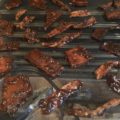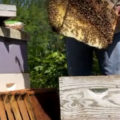The following is an update with concerns from the recent cold snap and how it could affect the 2014 growing season from Peter Hirst and Bruce Bordelon at the Purdue Ag. Extension. I follow Bruce extensively and have spoken to him a number of times in the past. He’s a great person to know if you’re growing grapes in the Midwest. Check out some of the drastic steps I have taken around the ranch in the past with cold temps.
With the frigid temperatures blanketing the state, damage to fruit crops is likely. We were fortunate in having good snow cover prior to cold temperatures to protect roots from damage. Trying to predict the amount of bud/tree/vine damage we might expect is a little complicated because damage is influenced by many factors including minimum temps, duration of cold temps, acclimation and previous season’s crop load. The temperature in West Lafayette and across much of the midwest has been as low as –15 F or so. What damage can we expect at these temperatures? Apples and Pears are very hardy but we’re close to the temperatures where we could start to see some bud damage. It seems unlikely that bud damage will be severe enough to reduce crops.
Peaches and Nectarines – The rule of thumb I learned from Dick Hayden is that you start to see some flower bud kill at –10 F and for every degree below –10 F you lose 10% of your flower buds. At –20F expect complete flower bud mortality. Given that the temperature here right now is –13 F (and assuming this is as bad as it gets), we expect to have some early thinning occurring but crop reduction shouldn’t be too severe.
Sweet and tart cherries – tart cherries are a little more hardy than sweets, but we could see a little bud damage to both sweets and tarts, but at current temps this is unlikely to limit 2014 crops.
Blueberries – highbush blueberries are generally tolerant of temperatures down to –15, but the extended period of cold will likely lead to some flower bud kill.
Blackberries – thorny and thornless blackberries are not hardy below –10 so we would expect to see considerable damage to vascular tissue in canes and potentially buds themselves. In severe cases we would expect all above ground growth to be killed. Blackberries commonly exhibit a delayed winter injury response where the buds may have survived the winter cold and begin to grow in the spring, but the damage to the vascular tissue in the canes results in collapse of the new growth a few days or weeks after the start of growth.
Raspberries – red and black raspberries are fairly cold hardy and we would expect minimal damage to varieties that are adapted to the Midwest. Some red raspberry varieties from the Pacific Northwest are not very cold hardy and may have been damaged.
Grapes – varieties will vary widely in amount of damage. Grapes have a compound bud, with primary, secondary and tertiary growing points. The primaries are usually the first to show cold damage. We would expect hardy hybrid and American varieties to have 0-25% primary bud damage at the temperatures we experienced. That is manageable as we can adjust pruning severity to account for those losses. Less hardy hybrids may have 50% or more bud damage, which could lead to some yield reduction and potentially cane and cordon damage. Cold tender vinifera varieties likely have experienced considerable damage to buds, canes, and cordons and possible damage to trunks above the snow line.
The extended duration of cold temperatures expected may increase the amount of damage we see. We’ll know more in a week or so. Right now there’s nothing growers can do except stay inside, keep warm, and keep their fingers crossed.









Leave a Reply